An environmentally friendly wound dressing based on a self-healing, extensible and compressible antibacterial hydrogel
Abstract
The design of wound dressing hydrogels is of utmost importance in healthcare with desired remedial effects, self-healing ability, cell affinity, and appropriate mechanical properties, particularly for healing skin wounds; excellent wound tissue adhesiveness is imperative. Here, an ultra-tough and self-healable double-network (DN) hydrogel is designed based on salep/poly(vinyl alcohol) that is endowed with superior tissue adhesiveness and cell affinity as demonstrated for critical and burn wound healing in rats. The self-healing capability of the hydrogel is attained via hydrogen bonds and Schiff-base cross-linking between oxidized salep (OSa) and ethylene diamine-modified salep (SaHEA) chains (OSEA network). The interaction of hydroxyl groups of the poly(vinyl alcohol) (PVA) network effectively facilitates to create a stable mechanical structure and endow self-healing ability. The ensuing novel hydrogel is endowed with excellent self-healing ability, high mechanical strength (Young's modulus of up to 14 kPa; high fracture energy of up to 90 kJ m−3; compressive stress of 400 kPa), good tissue adhesiveness (up to 48 N m−1 adhesive strength), and superior therapeutic properties (cell viability of A375 cells >80%; remarkable healing of >60% in 14 and >98% in 21 days). The macroscopic evaluation revealed healing >80% in 14 days and 100% in 21 days that is achieved by combining both networks in a single system along with Arnebia extract and Ag nanoparticles (Ag NPs) in green media. In vitro and in vivo tests affirmed that the PVA/OSEA DN hydrogel could be an excellent candidate for skin tissue regeneration in medical applications.



 Please wait while we load your content...
Please wait while we load your content...